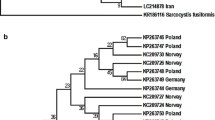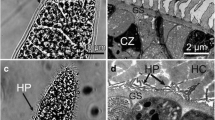Abstract
Phylogenetic analyses based on sequences of the nuclear-encoded small subunit rRNA (ssurRNA) gene were performed to examine the origin, phylogeny, and biogeographic relationships of Sarcocystis neurona isolates from opossums and horses from the State of Michigan, USA, in relation to other cyst-forming coccidia. A total of 31 taxa representing all recognized subfamilies and genera of Sarcocystidae were included in the analyses with clonal isolates of two opossum and two horse S. neurona. Phylogenies obtained by the four tree-building methods were consistent with the classical taxonomy based on morphological criteria. The “isosporid” coccidia Neospora, Toxoplasma, Besnoitia, Isospora lacking stieda bodies, and Hyaloklossia formed a sister group to the Sarcocystis spp. Sarcocystis species were divided into three main lineages; S. neurona isolates were located in the second lineage and clustered with S. mucosa, S. dispersa, S. lacertae, S. rodentifelis, S. muris, and Frenkelia spp. Alignment of S. neurona SSU rRNA gene sequences of Michigan opossum isolates (MIOP5, MIOP20) and a S. neurona Michigan horse isolate (MIH8) showed 100% identity. These Michigan isolates differed in 2/1085 bp (0.2%) from a Kentucky S. neurona horse isolate (SN5). Additionally, S. neurona isolates from horses and opossums were identical based on the ultrastructural features and PCR-RFLP analyses thus forming a phylogenetically indistinct group in these regions. These findings revealed the concordance between the morphological and molecular data and confirmed that S. neurona from opossums and horses originated from the same phylogenetic origin.




Similar content being viewed by others
References
Akaike H (1974) Information theory and an extension of the maximum likelihood principle. In: Petrov BN, Csaki F (eds) Proceedings of the 2nd international symposium on information theory. Akademia Kiado, Budapest Hungary, pp 267–281
Barta JR, Jenkins MC, Danforth HD (1991) Evolutionary relationships of avian Eimeria species among other apicomplexan protozoa: monophyly of the Apicomplexa is supported. Mol Biol Evol 8:345–355
Barta JR, Martin DS, Carreno RA, Siddall ME, Profous-Juchelkat H, Hozza M, Powles MA, Sundermann C (2001). Molecular phylogeny of the other tissue coccidia: Lankesterella and Caryospora. J Parasitol 87:121–127
Bremer K (1994) Branch support and tree stability. Cladistics 10:295–304
Carreno RA, Barta JR (1999) An eimeriid origin of isosporid coccidian with stieda bodies as shown by phylogenetic analysis of small subunit ribosomal RNA gene sequences. J Parasitol 85:77–83
Dolezel D, Koudela B, Jirk[Uring] M, Hypsa V, Obornik M, Votypka J, Modry D, Šlapeta JR, Lukes J (1999). Phylogenetic analysis of Sarcocystis sp. and Sarcocystis dispersa supports the co-evolution of Sarcocystis with the final hosts. Inter J Parasitol 29:795–798
Dubey JP, Lindsay DS, Saville WJ, Reed SM, Granstrom DE, Speer CA (2001) A review of Sarcocystis neurona and equine protozoal myeloencephalitis (EPM). Vet Parasitol 95:89–131
Efron B, Halloran E, Holmes S (1996) Bootstrap confidence levels for phylogenetic trees. Proc Natl Acad Sci USA 93, 13429–13434
Ellis JT, Holmdahl OJ, Ryce C, Njenga JM, Harper PA, Morrison DA (2000) Molecular phylogeny of Besnoitia and the genetic relationships among Besnoitia of cattle, wildebeest and goats. Protist 151:329–336
Elsheikha HM, Saeed MA, Fitzgerald SD, Murphy AJ, Mansfield LS (2003) Effects of temperature and host cell type on the in vitro growth and development of Sarcocystis falcatula. Parasitol Res 91:22–26
Escalante AA, Ayala FJ (1995) Evolutionary origin of Plasmodium and other Apicomplexa based on rRNA genes. Proc Natl Acad Sci USA 92:5793–5797
Felsenstein J (1981) Evolutionary trees from DNA sequences: a maximum likelihood approach. J Mol Evol 17:368–376
Felsenstein J (1988) Phylogenies from molecular sequences: Inference and reliability. Ann Rev Genetics 22:521–565
Fenger CK, Granstrom DE, Langemeier JL, Gajadhar A, Cothran G, Tramontin RR, Stamper S, Dubey JP (1994) Phylogenetic relationship of Sarcocystis neurona to other members of the family Sarcocystidae based on small subunit ribosomal RNA gene sequence. J Parasitol 80:966–975
Fenger CK, Granstrom DE, Gajadhar AA, Williams NM, McCrillis SA, Stamper S, Langemeier JL, Dubey JP (1997) Experimental induction of equine protozoal myeloencephalitis in horses using Sarcocystis sp. Sporocysts from opossums. Vet Parasitol 68:199–213
Frenkel JK (1977) Besnoitia wallacei of cats and rodents: with a reclassification of other cyst-forming isosporoid coccidia. J Parasitol 63:611–628
Frenkel JK, Dubey JP (1972) Rodents as vectors for feline coccidia, Isospora felis and Isospora rivolta. J Infec Dis 125:69–72
Hasegawa M, Iida Y, Yano T, Takaiwa F, Iwabuchi M (1985a) Phylogenetic relationships among eukaryotic kingdoms inferred from ribosomal RNA sequences. J Mol Evol 22:32–38
Hasegawa M, Kishino H, Yano T (1985b) Dating of the human-ape splitting by a molecular clock of mitochondrial DNA. J Mol Evol 21:160–174
Hofacker IL, Fekete M, Stadler PF (2002) Secondary structure prediction for aligned RNA sequences. J Mol Biol 319:1059–1066
Huelsenbeck JP, Rannala B (1997) Phylogenetic methods come of age: testing hypotheses in an evolutionary context. Science 276:227–232
Huelsenbeck JP, Ronquist T F (2001) MrBayes: Bayesian inference of phylogeny. Biometrics, pp 17754–17755
Jakes KA (1998) Sarcocystis mucosa in Bennetts wallabies and pademelons from Tasmania. J Wildl Dis 34:594–599
Jenkins MC, Ellis JT, Liddell S, Ryce C, Munday BL, Morrison DA, Dubey JP (1999) The relationship of Hammondia hammondi and Sarcocystis mucosa to other heteroxenous cyst-forming coccidia as inferred by phylogenetic analysis of the 18S SSU ribosomal DNA sequence. Parasitology 119:135–142
Jukes TH, Cantor CR (1969) Evolution of protein molecules. In: Munro HN (ed) Mammalian Protein Metabolism vol. 3. Academic Press, New York, pp 21–132
Kimura M (1980) A simple method for estimating evolutionary rate of base substitutions through comparative studies of nucleotide sequences. J Mol Evol 16:111–120
Kishino H, Hasegawa M (1989) Evaluation of the maximum likelihood estimate of the evolutionary tree topologies from DNA sequence data, and the branching order in Hominoidea. J Mol Evol 29:170–179
Levine ND (1985) Phylum II. Apicomplexa Levine 1970. In: Lee JJ, Hutner SH, Bovee EC (eds) An Illustrated Guide to the Protozoa. Society of Protozoologists, Lawrence, pp 322–374
Lockhart PJ, Steel MA, Hendy MD, Penny D (1994) Recovering evolutionary trees under a more realistic model of sequence evolution. Mol Biol Evol 12:605–612
Maddison WP, Maddison DR (2000) MacClade: analysis of phylogeny and character Evolution, version 4.0. Sinauer Associates, Massachusetts Sunderland
Mansfield LS, Schott HC II Murphy AJ, Rossano MG, Tanhauser SM, Patterson JS, Nelson K, Ewart SL, Marteniuk JV, Bowman DD, Kaneene JB (2001) Comparison of Sarcocystis neurona isolates derived from horse neural tissue. Vet Parasitol 95:167–178
Mugridge NB, Morrison DA, Johnson AM, Luton K, Dubey JP, Votypka J, Tenter AM (1999) Phylogenetic relationships of the genus Frenkelia: a review of its history and new knowledge gained from comparison of large subunit ribosomal ribonucleic acid gene sequences. Inter J Parasitol 29:957–972
Murphy AJ, Mansfield LS (1999) Simplified technique for isolation, excystation, and culture of Sarcocystis spp. from opossums. J Parasitol 85:979–981
Posada D, Crandall KA (1998) MODELTEST: testing the model of DNA substitution. Bioinformatics 14:817–818
Richardson BJ (1988) A new view of the relationships of Australian and American marsupials. Aust Mammal 11:71–73
Rosenthal BM, Lindsay DS, Dubey JP (2001). Relationships among Sarcocystis species transmitted by New World opossums (Didelphis spp.). Vet Parasitol 95:133–142
Saitou N, Nei M (1987) The neighbor-joining method: a new method for reconstructing phylogenetic trees. Mol Biol Evol 4:406–425
Slapeta JR, Modry D, Votypka J, Jirku M, Koudela B, Lukes J (2001) Multiple origin of the dihomoxenous life cycle in sarcosporidia. Inter J Parasitol 31:413–417
Slapeta JR, Modry D, Votypka J, Jirku M, Lukes J, Koudela B (2003) Evolutionary relationships among cyst-forming coccidia Sarcocystis spp. (Alveolata: Apicomplexa: Coccidea) in endemic African tree vipers and perspective for evolution of heteroxenous life cycle. Mol Phylogenet Evol 27:464–475
Smith DD, Frenkel JK (2003) Determination of the genera of cyst-forming coccidia. Parasitol Res 91:384–389
Swofford DL (2002) PAUP*. Phylogenetic analysis using parsimony (* and other methods). Version 4. Sinauer Associates, Sunderland, MA
Swofford DL, Olsen GL, Waddell PJ, Hillis DM (1996) Phylogenetic inference. In: Hillis DM, Moritz C, Mable BK (eds) Molecular Systematics, 2nd edn. Sinauer Associates, Sunderland, Massachusetts, pp 407–514
Tamura K, Nei M (1993) Estimation of the number of nucleotide substitutions in the control region of mitochondrial DNA in humans and chimpanzees. Mol Biol Evol 10:512–526
Tanhauser SM, Yowell CA, Cutler TJ, Greiner EC, MacKay RJ, Dame JB (1999) Multiple DNA markers differentiate Sarcocystis neurona and Sarcocystis falcatula. J Parasitol 85:221–228
Tenter AM, Baverstock PR, Johnson AM (1992) Phylogenetic relationships of Sarcocystis species from sheep, goats, cattle and mice based on ribosomal RNA sequences. Int J Parasitol 22:503–513
Thompson JD, Gibson TJ, Plewniak F, Jeanmougin F, Higgins DG (1997) The ClustalX windows interface: flexible strategies for multiple sequence alignment aided by quality analysis tools. Nucleic Acids Res 25:4876–4882
Veevers JJ (1991) Phanerozoic Australia in the changing configuration of Proto-Pangea through Gondwanaland and Pangea to the present dispersed continents. Aust Syst Bot 4:1–11
Westerman M, Janczewski DN,O’Brien SJ (1990) DNA-DNA hybridisation studies and marsupial phylogeny. In: Marshall Graves JA, Hope RM, Cooper DW (eds) Mammals from pouches and eggs: Genetics. breeding and evolution of marsupials and monotremes, pp 173–181
Yang Z (1994) Maximum likelihood phylogenetic estimation from DNA sequences with variable rates over sites: approximate methods. J Mol Evol 39:105–111
Acknowledgments
We thank Dr. Thomas S. Whittam for his kind support and for making critical comments on the manuscript. The study was supported by a Grant 61–6123 from the Grayson Jockey-Club Research Foundation. This work was carried out in accordance to the law and regulations of the USA.
Author information
Authors and Affiliations
Corresponding author
Electronic Supplementary Material
Rights and permissions
About this article
Cite this article
Elsheikha, H.M., Lacher, D.W. & Mansfield, L.S. Phylogenetic relationships of Sarcocystis neurona of horses and opossums to other cyst-forming coccidia deduced from SSU rRNA gene sequences. Parasitol Res 97, 345–357 (2005). https://doi.org/10.1007/s00436-005-1396-5
Received:
Accepted:
Published:
Issue Date:
DOI: https://doi.org/10.1007/s00436-005-1396-5




